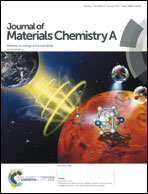A dopamine modified Li6.4La3Zr1.4Ta0.6O12/PEO solid-state electrolyte: enhanced thermal and electrochemical properties†
Abstract
A garnet-type solid-state electrolyte Li6.4La3Zr1.4Ta0.6O12 (LLZTO) was modified using dopamine to improve the wettability of LLZTO with PEO, allowing 80 wt% LLZTO to be uniformly dispersed in 20 wt% PEO/LiTFSI polymer electrolyte. Transmission electron microscopy and Fourier transform infrared spectroscopy confirmed a 4–5 nm thick polydopamine (PDA) layer coating on LLZTO nanoparticles. The composite LLZTO@PDA/PEO electrolyte was synthesized using a solvent casting method. The composite electrolyte has good compatibility and adhesion with both positive and negative electrodes of Li-ion batteries owing to the superior wetting capability of dopamine. This property allows for improved interfacial contact at the electrode/solid electrolyte interface which can decrease the overall resistance of the battery. With dopamine modification, the conductivity of the composite electrolyte at 30 °C increased from 6.3 × 10−5 S cm−1 to 1.1 × 10−4 S cm−1, and the interfacial resistance between the composite electrolyte and a metallic lithium anode decreased from 308 Ω cm2 to 65 Ω cm2 at 50 °C. The composite electrolyte also demonstrated improved thermal stability.



 Please wait while we load your content...
Please wait while we load your content...